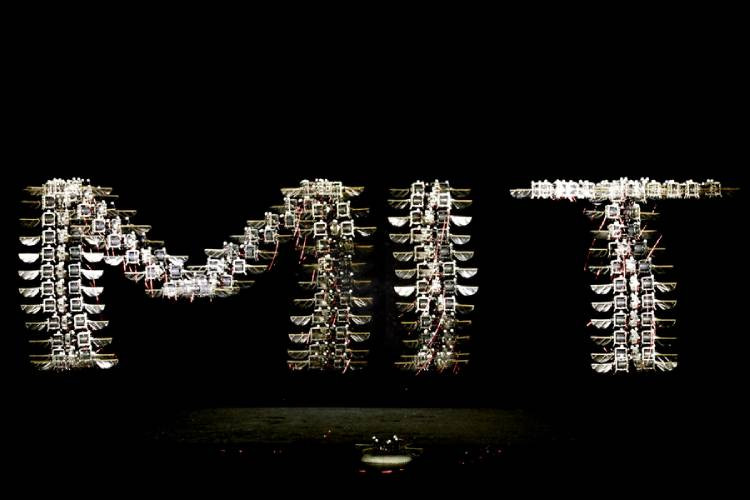Fast and Agile Robotic Insects Could Transform Crop Pollination
Insights | 07-03-2025 | By Robin Mitchell

While conventional pollination methods have long relied on nature’s own workforce—bees, butterflies, and other vital insects—rapid changes in agricultural practices and the environment have highlighted the need for innovative and sustainable solutions. Recently, researchers at the Massachusetts Institute of Technology (MIT) unveiled a notable breakthrough in pollination technology: miniature robotic insects engineered to emulate natural pollinators.
Key Things to Know:
- MIT researchers have developed robotic insects capable of pollination, mimicking the agility and endurance of real bees.
- These micro-robots utilise advanced aerodynamics and lightweight energy sources to improve flight stability and efficiency.
- If scaled for commercial use, robotic pollinators could enhance crop yields, support vertical farming, and reduce reliance on natural pollinators.
- Despite their potential, experts emphasise that robotic pollination should complement—not replace—natural pollinators to maintain ecosystem balance.
What challenges does modern agriculture face, what exactly have these MIT researchers developed, and what are the potential impacts of these tiny, flapping-wing robots on our future food supply and ecosystems?
The Buzz Behind the Decline – Understanding Pollination Challenges in Modern Agriculture
The relationship between agriculture and pollinators has been a symbiotic one for centuries, with bees playing a critical role in pollinating crops. Traditional farming practices relied heavily on the natural services of these pollinators, often leaving fields untended to allow wildflowers to bloom and attract bees. This approach not only benefited the bees but also resulted in healthier crops, with the introduction of beneficial pollinators increasing yields and improving crop quality.
Why Bee Population Decline Threatens Ecosystems
Bees are some of the most important pollinators, responsible for pollinating a vast majority (around 80%) of the world's crops. Without bees, many of our staple foods would cease to exist, including fruits, vegetables, nuts, and seeds. The importance of bees goes beyond just their role in pollination; they are also a key indicator of environmental health. A decline in bee populations can signal larger issues with ecosystem balance, including the presence of pesticides and other pollutants that can harm their health.
Despite the critical role that bees play in pollination, there are significant challenges facing their populations. The widespread use of pesticides, particularly neonicotinoids, has been shown to have a devastating impact on bee colonies, causing colony collapse and impacting pollination capabilities. Monoculture crops, while profitable, can be damaging to bee populations, as they lack the diversity of wildflowers and other plants that bees rely on for food and shelter. The increasing use of technology in agriculture, while providing significant benefits in terms of yield and efficiency, can also have a negative impact on pollinators, as it replaces natural pollinators with artificial systems.
Beyond Bees: The Importance of Other Pollinators
However, while technology has come a long way in developing artificial pollination systems, there are still significant limitations to these solutions. Robotic insects, for example, are being developed to mimic the behaviour of real bees, but these systems are still in their infancy and face numerous challenges in terms of scalability and ecological integration. These systems are often unable to fully replicate the complex behaviours of real pollinators, which can include complex flight patterns, communication systems, and social structures. Furthermore, artificial pollination systems can be expensive and difficult to deploy, making them impractical for widespread use.
In addition to the challenges faced by bees, other pollinators, such as butterflies and moths, also play a critical role in the pollination of many crops. These insects are often less well understood than bees but are equally important in maintaining the health of ecosystems and ensuring the production of high-quality crops. However, the decline of these pollinators is often overlooked, and their importance in pollination is frequently underestimated. This lack of recognition can have serious consequences, as the loss of these pollinators can have a significant impact on food production and ecosystem balance.
As the world grapples with the challenges of climate change, food security, and sustainable development, the importance of pollinators cannot be overstated. The decline of pollinators has serious consequences for food production, ecosystem balance, and human well-being. In order to address these challenges, we must prioritise the conservation and protection of pollinators, as well as the habitats and ecosystems that they rely on. By working together, we can ensure a healthy and productive future for pollinators, and the crops that we all rely on.
MIT Scientists Develop Robotic Insects for Pollination
In a breakthrough that could change the future of agriculture, researchers at the Massachusetts Institute of Technology (MIT) have successfully developed tiny robotic insects capable of pollination. The miniature robots, weighing less than a gram, have flapping wings that mimic the movement of bees, showcasing agility and endurance similar to insects.
According to a paper published in the Journal of Robotics Science, the researchers aimed to address the limitations of mechanical and artificial pollination methods. While robots have been developed for this purpose, they often lack the speed, aerial versatility, and durability of bees and other real insects.
To overcome these limitations, the MIT team designed micro-robots with enhanced aerodynamics and precision control mechanisms. Unlike previous robotic pollinators that struggled with stability, these new prototypes utilise a refined wing configuration that reduces turbulence and improves lift efficiency.
Furthermore, the researchers are actively working on integrating lightweight energy sources, such as ultrathin solar cells, to extend flight duration. This innovation could allow these robotic pollinators to operate autonomously in large-scale farming environments without frequent recharging.
Expanding Applications in Controlled-Environment Farming
The new design, which has been tested and proven to be efficient, is a significant advancement in the field of robotics and agriculture. If implemented on a large scale, these robots could potentially increase crop yields exponentially, reducing the need for manual labour and minimising the environmental impact associated with large-scale farming.
In addition to improving crop productivity, these robotic pollinators could mitigate risks associated with declining bee populations. Research suggests that over-reliance on traditional pollinators makes food systems vulnerable to environmental disruptions. By introducing artificial pollinators as a supplementary tool, agricultural sectors can enhance resilience against ecosystem imbalances.
Advanced Robotics for Precision Pollination
Moreover, these robots could play a vital role in controlled-environment agriculture, such as vertical farms and greenhouses, where natural pollinators are not present. Their ability to navigate confined spaces with precision makes them well-suited for pollination in urban farming and high-tech agricultural setups.
The robotic insects, which are capable of hovering for up to 16 minutes, can fly complex paths at speeds of 30 cm per second, making them a viable alternative to traditional pollination methods. The researchers have also demonstrated the robots' ability to perform fast flips and manoeuvres, showcasing their agility and endurance.
A key factor behind this enhanced agility is the improved micro-actuator design, which enables finer control over wing movements. Inspired by the biomechanics of bees, the actuators allow the robotic insects to stabilise mid-flight, making them more adaptable to real-world agricultural conditions.
The Future of Robotic Pollinators in Agriculture
The ability to execute rapid aerial manoeuvres is essential for effective pollination, as real insects often encounter unpredictable airflow patterns around flowers. By mimicking natural flight dynamics, these robots can enhance pollination efficiency, even in challenging weather conditions.
While the idea of robotic pollination is not new, the development of these miniature robots represents a significant milestone in the field of robotics. The use of robotic insects for pollination has the potential to transform the agricultural industry, providing a sustainable and efficient solution for food production.
Balancing Innovation with Ecological Responsibility
The researchers at MIT have already begun testing the robots in controlled environments, with plans to scale up the technology for commercial use. While the robots are still in the experimental phase, they have shown promising results, demonstrating their potential to revolutionise the field of agriculture and beyond.
Despite these advancements, ethical concerns remain regarding the long-term impact of artificial pollination. Experts emphasise that robotic solutions should complement—not replace—natural pollinators, as biodiversity plays a crucial role in maintaining healthy ecosystems.
There is also the question of cost and accessibility. While this technology shows promise, widespread adoption in commercial farming will depend on affordability and scalability. Researchers are currently exploring ways to reduce manufacturing costs and improve the durability of these micro-robots, making them viable for mass deployment.
Beyond the Bloom: Envisioned Tomorrow's Pollination Path
As we continue to navigate the challenges posed by modern agriculture, it is imperative that we look beyond the current state of pollination and envision a future where technology and nature coexist in harmony. While the development of innovative pollination devices, such as robotic insects, is a significant step in this direction, it is crucial that we prioritise conservation-led strategies to ensure that these technologies serve as a supplement, rather than a substitute, for natural pollinators.
To achieve this, we must prioritise proactive efforts to address the root causes of pollinator decline rather than solely relying on technological solutions. By addressing issues such as habitat loss, pesticide use, and climate change, we can create a more resilient and diverse ecosystem that supports a wide range of pollinators. This will not only ensure the long-term health of pollinator populations but also contribute to a more sustainable food system that benefits both people and the planet.

